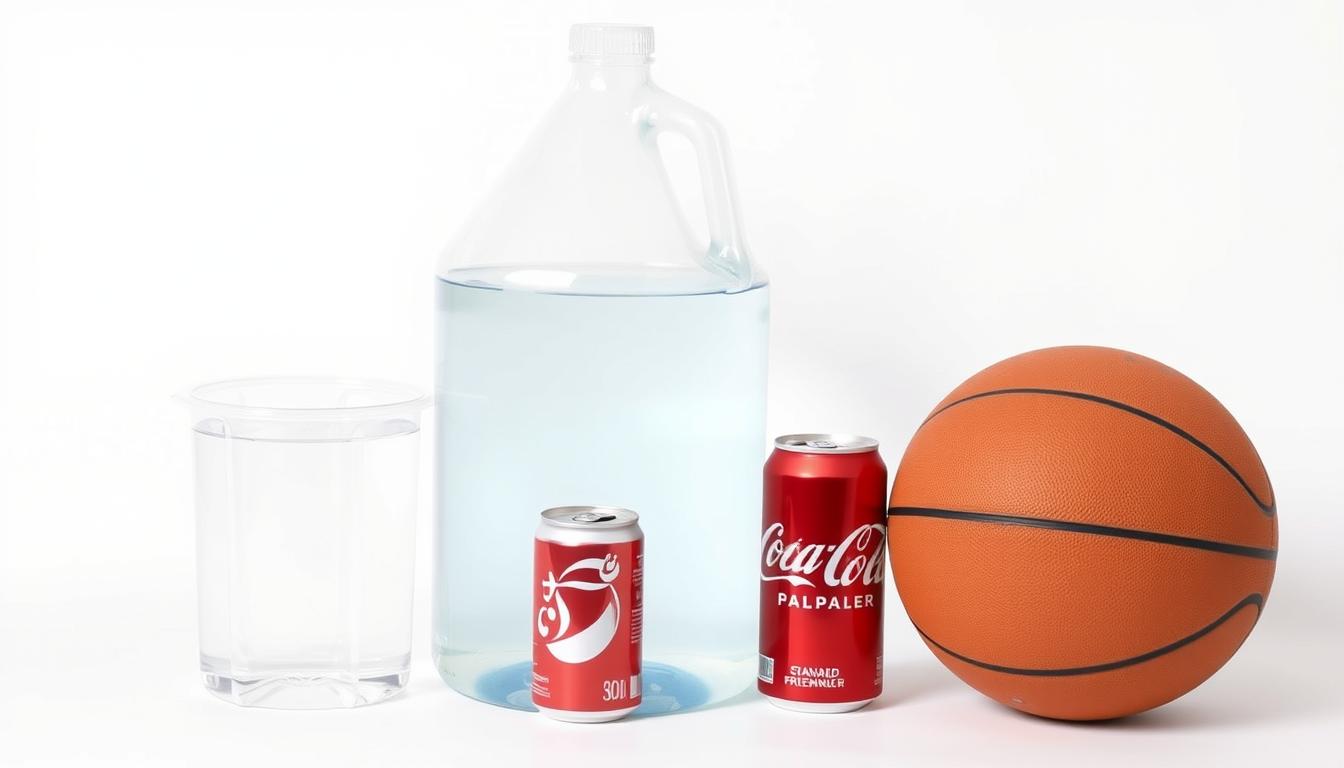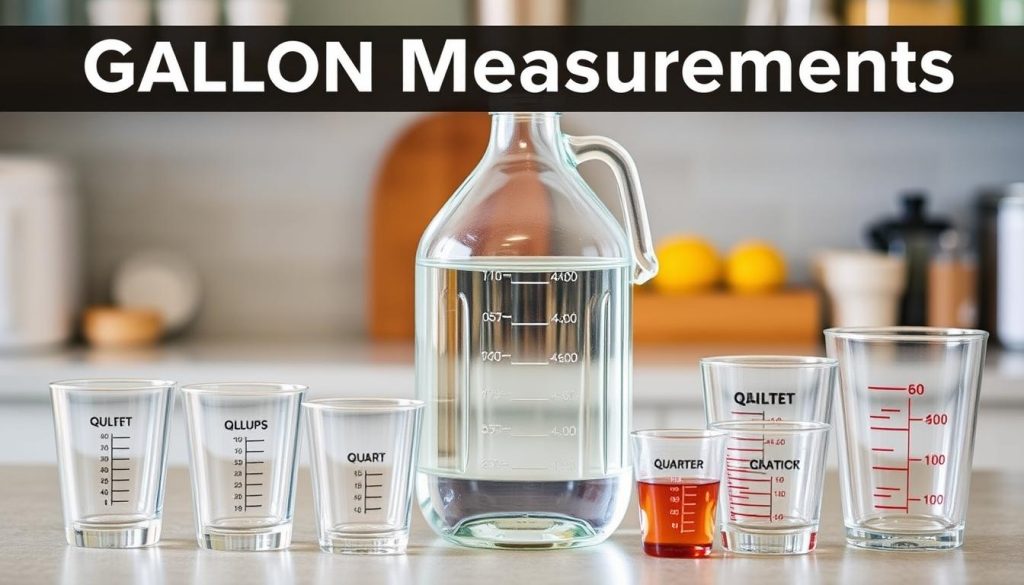
The US liquid gallon is 16.7% smaller than the imperial gallon. This fact shows why understanding water measurement units and gallon capacity is crucial. Let’s explore different gallons, their dimensions, and visualize a gallon of water’s true size.
This guide will help you grasp the size of a gallon of water. You’ll learn about liquid volume conversions and the weight of a gallon.
By the end, you’ll understand how a gallon of water relates to your daily life. This knowledge can improve your hydration habits and measurement skills.
Understanding Gallon Measurements
The gallon is a common unit for measuring liquids in the United States and other countries. Different types of gallons exist, each with its own definition. Let’s explore these measurements to help you choose the right one.

US Liquid Gallon
The US liquid gallon is the standard for measuring liquids in the United States. It equals 231 cubic inches or 128 US fluid ounces. This measurement is used for water, milk, and gasoline in the US.
| Unit | Equivalent to 1 US Liquid Gallon |
|---|---|
| Cubic Inches | 231 |
| US Fluid Ounces | 128 |
| Liters | 3.785 |
Imperial Gallon
The imperial gallon is used in some Commonwealth countries and equals 4.546 liters. It’s about 20% larger than the US gallon, equaling roughly 153 US fluid ounces. The UK and Ireland replaced the imperial gallon with liters in the early 1970s.
Did you know that the imperial gallon has a long history? During Queen Elizabeth I’s reign, the ale gallon was equivalent to 4.621 liters, while the wine gallon introduced during Queen Anne’s reign equated to 3.785 liters.
US Dry Gallon
The US dry gallon is mainly used for measuring dry goods in agriculture. It’s 1/8 of a US bushel, equaling about 4.405 liters or 148.95 US fluid ounces. This measurement is roughly 16.4% larger than the US liquid gallon.
- The US dry gallon is equivalent to 268.8025 cubic inches.
- The Winchester (corn) gallon in England approximated 4.405 liters, similar to the US dry gallon.
Knowing these gallon measurements is important for accurate conversions. This knowledge is especially useful when dealing with international trade or recipes from different countries.
How Many Bottles of Water Is a Gallon?
Staying hydrated is crucial, and water bottles are a handy way to do it. Ever wondered how many water bottles make up a gallon? Let’s explore this question.
Conversion Formula
To find out how many bottles are in a gallon, we need to know the bottle size. Common sizes are 16.9 fl oz (500 ml) and 20 fl oz (591 ml).
Here’s the formula we use:
Number of Water Bottles = 128 ÷ Bottle Size (in fl oz)
Let’s use a 16.9 fl oz bottle as an example:
Number of 16.9 fl oz Water Bottles = 128 ÷ 16.9 = 7.57 bottles
Common Bottle Sizes
Here’s a quick guide to the number of water bottles in a gallon for common sizes:
| Bottle Size (fl oz) | Number of Bottles in a Gallon |
|---|---|
| 8 fl oz | 16 |
| 12 fl oz | 10.67 |
| 16.9 fl oz (500 ml) | 7.57 |
| 20 fl oz | 6.4 |
| 24 fl oz | 5.33 |
| 33.8 fl oz (1 liter) | 3.78 |
These numbers are approximate. The actual volume of water in a bottle may vary slightly due to manufacturing.
Now you can easily figure out how many bottles you need to reach your daily water goals. Staying hydrated is key to good health, no matter what bottle size you prefer.
How Big Is a Gallon of Water?
A gallon of water in the US equals 128 fluid ounces. This standard unit helps us compare it to everyday items.
Let’s explore some size comparisons and visualize what a gallon of water looks like.
Gallon Size Comparison
A gallon of water is equivalent to:
- Eight 16.9-ounce water bottles
- Five 24-ounce water bottles
- Four 32-ounce water bottles
- Three 40-ounce water bottles
- Two 64-ounce Pro Jugs from Muscle Pound
These comparisons help us understand a gallon’s volume better. To drink a gallon daily, you’d need about 7.5 standard 16.9-ounce water bottles.
Visualizing a Gallon of Water
Picturing a gallon of water can be tricky. Here are some ways to visualize it:
- Imagine four 1-liter bottles of soda or water side by side. A gallon is slightly larger, equaling about 3.78 liters.
- Think of a standard milk jug from the grocery store. Most US milk jugs hold one gallon.
- Picture a large pitcher that can hold about 16 cups of water. This is roughly a gallon’s capacity.
Our bodies are about 60% water, with muscles containing over 70%. Many health experts recommend drinking a gallon daily for proper hydration.
This amount supports nutrient transport, digestion, toxin removal, and muscle and joint health.
| Container | Volume (oz) | Number Needed for a Gallon |
|---|---|---|
| Standard water bottle | 16.9 | 7.57 |
| Large water bottle | 24 | 5.33 |
| Extra-large water bottle | 40 | 3.2 |
| Pro Jug (Muscle Pound) | 64 | 2 |
The number of containers needed for a gallon depends on their individual volumes. Daily water needs vary based on factors like age, weight, and activity level.
Conclusion
Understanding gallon sizes is vital for daily life. The US liquid gallon equals 128 fluid ounces or 3.785 liters. This knowledge helps in cooking, hydration, and water usage calculations.
Proper hydration is crucial for health. Women should drink 2.7 liters daily, while men need 3.7 liters. These amounts may vary based on activity and climate.
Even slight dehydration can affect cognitive function and physical performance. Knowing gallon sizes helps us make smart hydration choices. We can use water bottles, gallon containers, or eat water-rich foods.
By staying aware of our water intake, we maintain good health. This knowledge empowers us to meet our hydration needs effectively. Proper hydration is key to our overall well-being.







